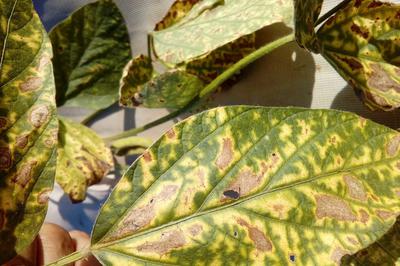Sudden Death Syndrome
Fusarium virguliforme
Fungus
In a Nutshell
- Scattered, diffuse, yellow spots between leaf veins.
- Growing and drying of spots, may fall out.
- Brown discoloration of stem and root.
- Flowers may abort.
Can also be found in
Symptoms
Small, pale green circular spots appear on leaves during flowering stage. Interveinal chlorosis and later necrosis show on leaves. As the disease progresses, the necrotic tissue between the veins may die and fall out, giving the leaves a ragged appearance. Leaves can eventually dry, curl or drop off but the petiole remains attached to the stem. Signs of rotting (brown discoloration) appear in the internal tissues of the lower stem and main root. Flowers may abort and pods may not develop or fill.
Recommendations

Organic Control
To this day, no biological control of the fungus is known. Please contact us if you know of any.

Chemical Control
Always consider an integrated approach with preventive measures together with biological treatments if available. Foliar fungicides are not effective because the fungus remains in the root system. Instead, apply specific fungicides, such as fluopyram to the seeds.
What caused it?
The fungus Fusarium virguliforme survives as spores in soil or on infested crop residues. It infects and colonizes plants through the root early in the vegetative stage but symptoms may become apparent only during flowering. The infection is favored by cool and wet soils, rainy weather conditions, densely planted fields, poor drainage or compacted soils. Wounds of soybean cyst nematodes, pests and mechanical injuries from poor handling practices also favor the infection risk.
Preventive Measures
- Provide good drainage.
- Use high quality certified seeds.
- Plant tolerant or resistant varieties.
- Plant early in the season to avoid adverse weather conditions.
- Leave sufficient space between plants to ensure good ventilation.
- Monitor your field for first symptoms.
- Plow the field to avoid soil compaction.
- Rotate with non-host crops for the given period.



